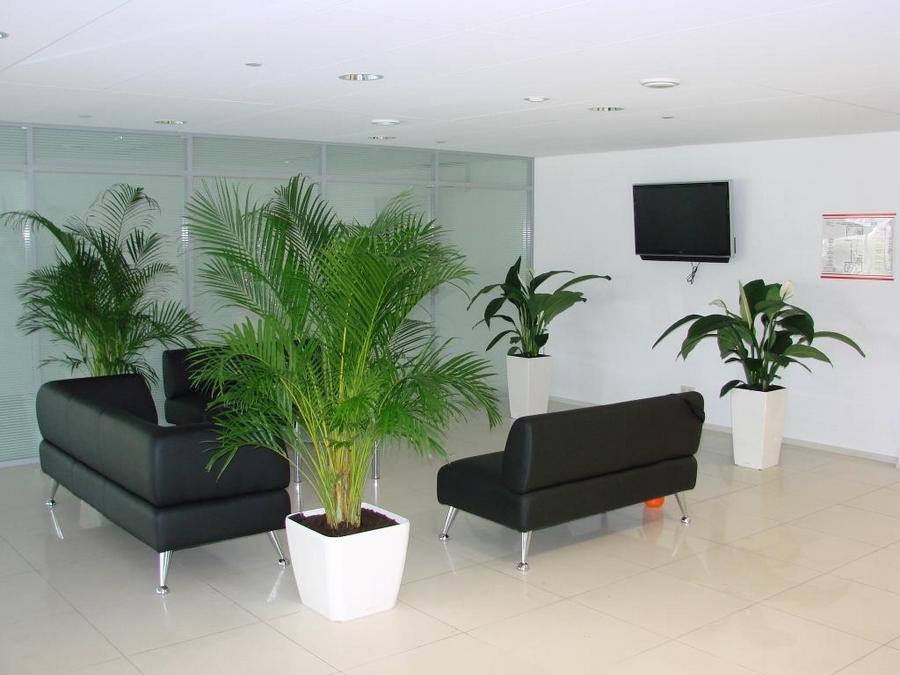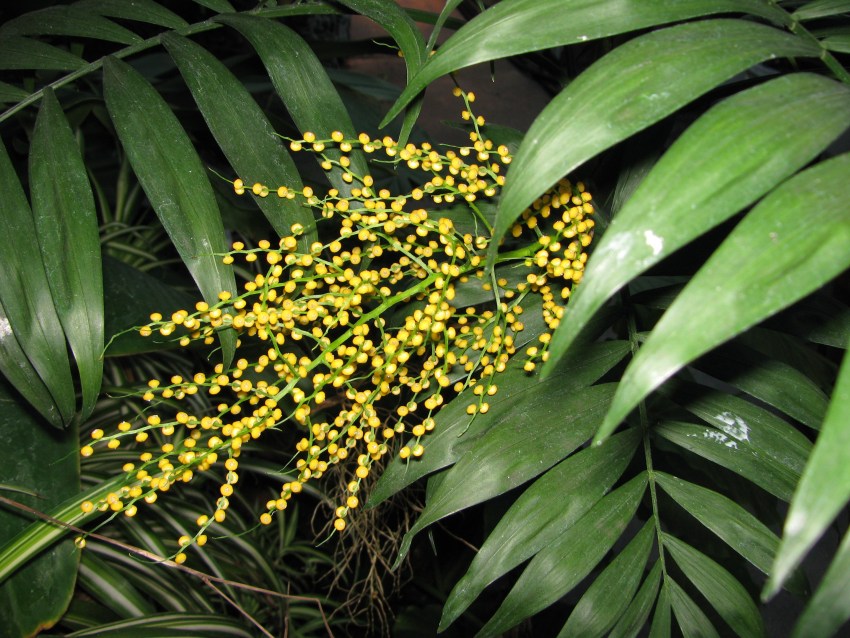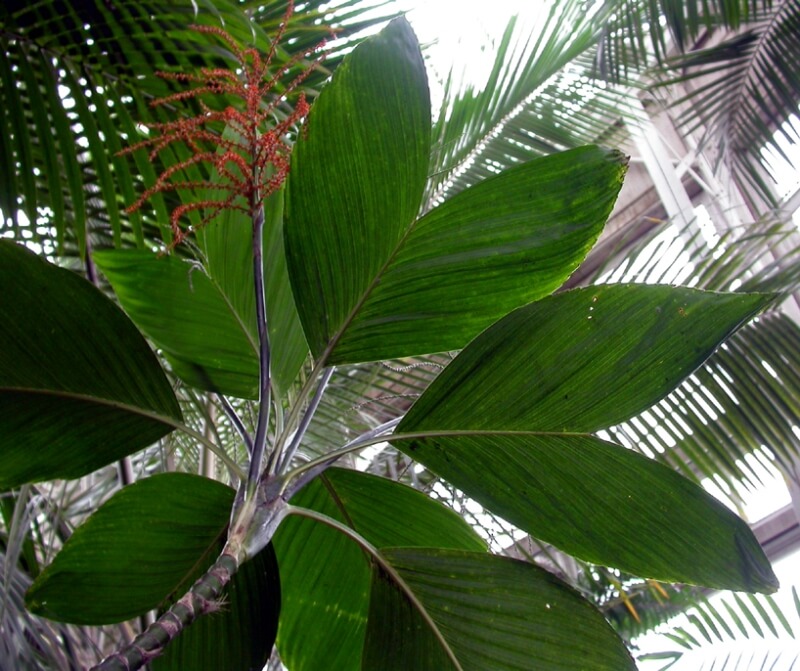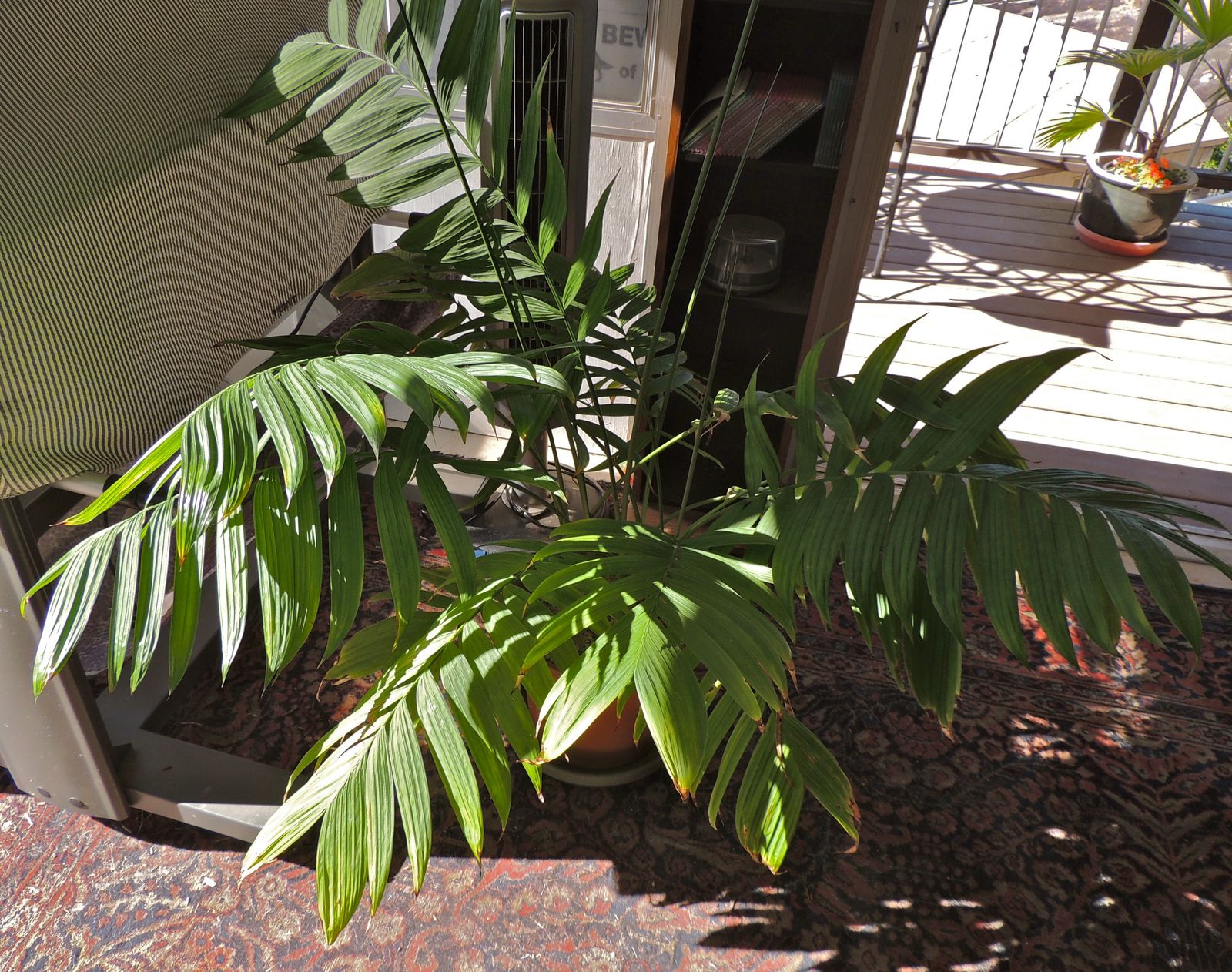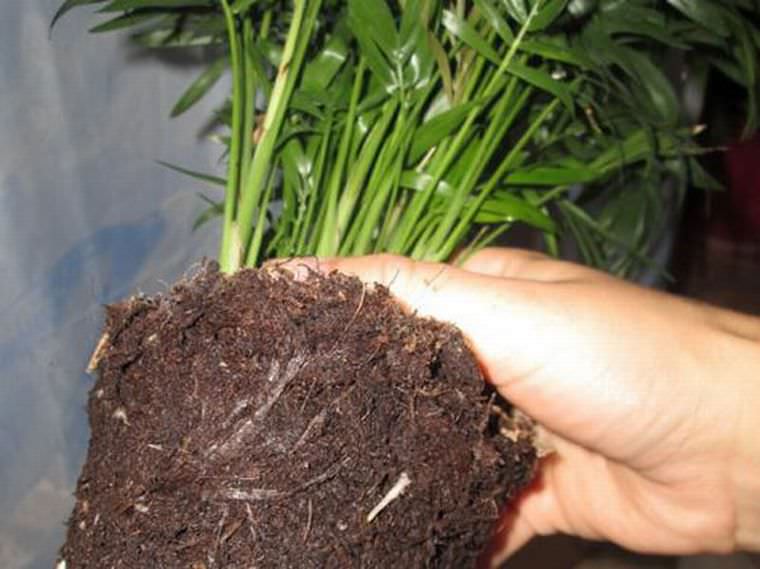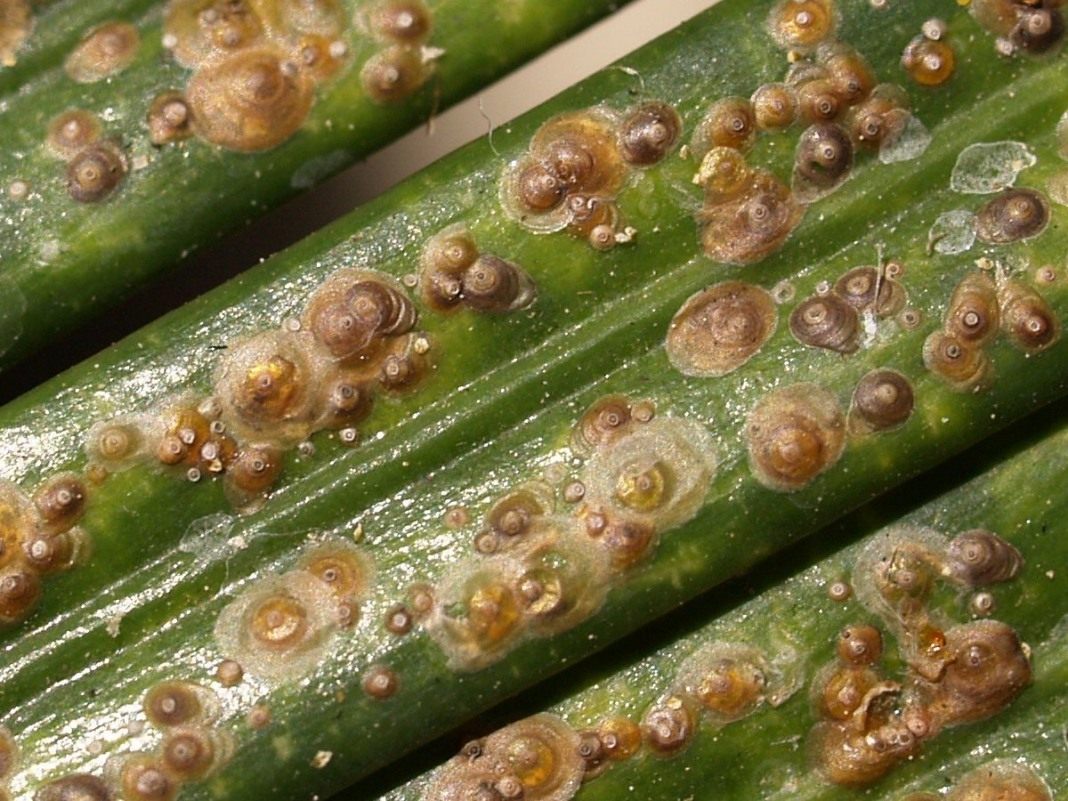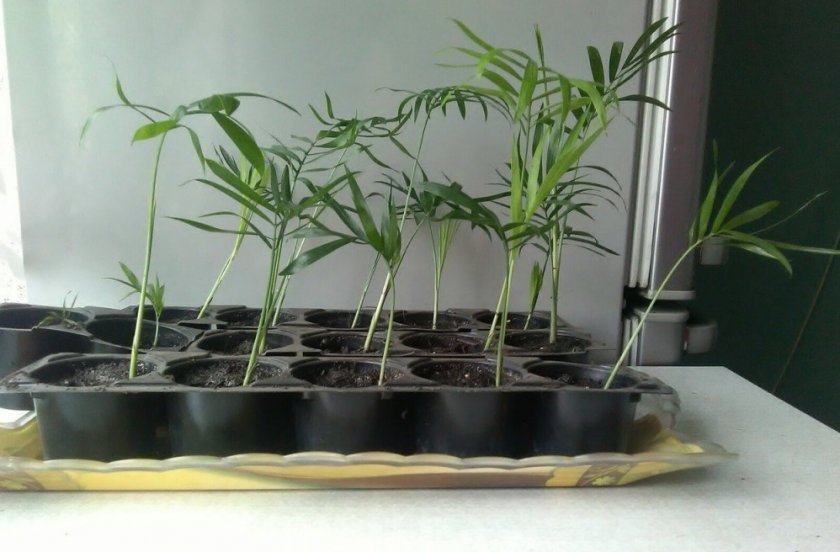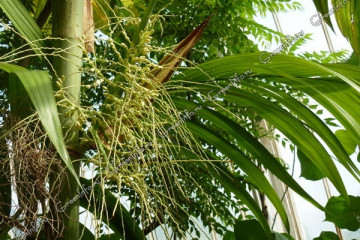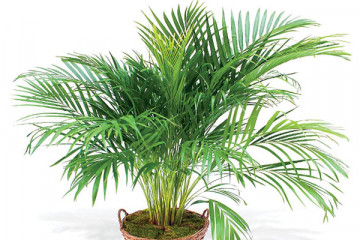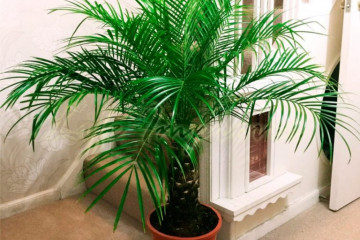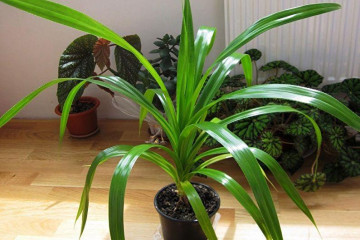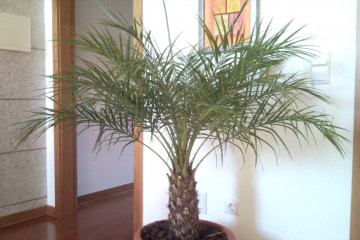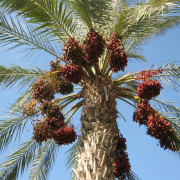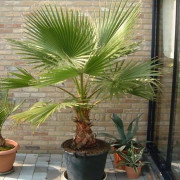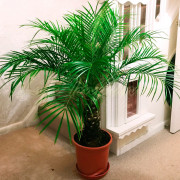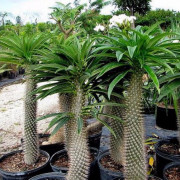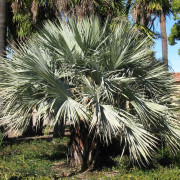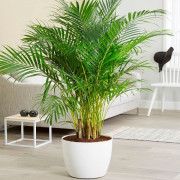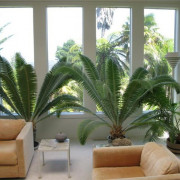Palm hamedorea - home care
Content:
The chamedorea flower is a popular houseplant, often used by housewives to add a special style to the interior. The plant resembles a palm tree and looks harmonious both in a large and bright living room, and in the corridors and offices of the office center. A tropical guest is unpretentious, but requires some attention to the conditions of detention.
Description of the popular varieties of hamedorea palm
Hamedorea palm has several types, each of which is interesting and unique in its own way.
Plants differ in leaf shape, care characteristics and some other parameters.
Hamedorea Bridble
This type of plant is one of the most popular among other palms. Its leaves are long-petiolate, each with an average of 14 pairs of narrow leaves. A chamedorea bridble is formed from numerous stems, their appearance resembles bamboo. Each sheet is directed vertically upward from the trunk with a slight bend. The palm tree blooms with dark yellow balls, reminiscent of a mimosa branch.
Hamedorea Ernest-August
Outwardly, Ernest-Augusta differs significantly from other representatives of her family in wide leaves. They may appear to resemble large hearts. The leaves are located in the upper part of the trunk, forming a rosette of 6-8 pieces. The end of each leaf is bifurcated, making it look like a heart. On the trunk you can see roots that did not seem to fit into the pot - these are aerial roots with which you can propagate the plant.
Hamedorea one-color
This hamedorrhea requires almost no care. Outwardly, it can be confused with the Elegance variety. However, unlike her, this species has a thinner stem, and more often they are inhabited by a bush. Outwardly, the leaves can be compared to the wet feathers of a large bird. The palm tree got its name according to one of the legends, for the fact that it blooms once in its life. There is a claim that the first flowering can be seen on a 70-year-old plant. The flowers themselves have the same kind of blooming mimosa.
Hamedorea metal
The representative of this variety is very similar to Ernest-August's chamedorea - she has the same dense and large leaves with two tips. But the color of the green part is different, why the plant got its name - the shade of the leaves has a pronounced metallic sheen. This variety is found in large private collections or botanical gardens, as well as at exhibitions.
Hamedorea elegans (chamaedorea elegans)
Chamedorea Elegance can be grown in height up to 2 meters, with proper home care and a specially selected pot depth. It has a large number of stems, each of which contains 6-7 long, feather-like leaves. The plant blooms regularly, regardless of the season and is the most common among its other relatives.
Features of home care
All varieties share some general rules of care that hamedorea needs - home care should provide tropical humidity and moderate air temperatures.She also does not like direct sunlight and drafts.
Pot selection
The pot must be taken at once of rather large size, so that as it grows, you do not have to transplant the plant. Choose the right deep pot, not a wide one, made of natural materials. Ceramic, clay or wood are perfect. Drainage must be placed on the bottom before planting.
Soil composition
In specialized stores, it is easy to find soil created specifically for palm trees. If this is not the case, you can prepare the land yourself by mixing in equal proportions:
- peat;
- sod land;
- humus.
Add sand to the resulting soil, the proportion of which should not exceed one seventh of the total volume of the pot. The resulting mixture is very light and allows air to pass through without difficulty, which ensures that the root system is kept healthy.
Fertilizing the soil
Fertilizers can be applied without harm to the plant only specially marked - "for palms". In the autumn-winter period, it is recommended to reduce the dose and the amount of dressings to 1 time per month and a half. From April to October, it is useful to water fertilizers twice a month. The plant also gladly accepts an alternative type of feeding - through the leaves.
Transfer after purchase
A palm tree that has just been brought home should be placed where direct sunlight will not reach the leaves, and no more manipulations should be made with it for 2 weeks, except for regular watering. After the allotted time for adaptation, you can transplant the tropical palm into a prepared pot. At the same time, it is important to remember that it is necessary to arrange a plant in a new place with an earthen lump. Any damage to the roots can lead to death, so they should not be cleared of the ground under any circumstances.
Watering and humidity
Any plant from the chamedorea family to plant indoors is very useful for two reasons: it purifies the air and requires humidity in the room. Both of these parameters are beneficial to human health. If he did not think before about the humidity in the room for himself, then after acquiring an elegant hamedorea or any other, he will have to do this. The humidity level should not fall below 55%. In order to monitor the state of the air in the room, you can purchase a hygrometer - on devices with a scale, values that are comfortable for a person are colored green, they are also suitable for a plant. If you don't have a humidifier, you will need to spray the leaves every day, except during the winter months.
You need to be careful with watering: until the top layer of the soil is dry, the plant is not touched. On average, watering in the warm season is carried out 2 times a week. In winter, you can water once every 5 days. The water must be soft, free from salts, not ice cold or warm. The optimum water temperature for irrigation is + 25˚С (the permissible maximum is +30).
Content temperature
It is not difficult to care for a palm tree, which is provided with proper watering and adequate air humidity. It is very important to observe the temperature regime in the room where the tropical guest lives. The thermometer should not rise above + 26˚С and fall below + 13˚С.
Why hamedorea dries up, leaves turn yellow
Chamedorea leaves may dry out due to improper care. With insufficient watering or dry indoor air, the tips of the foliage can turn yellow and fall off. To prevent this from happening, it is important to monitor the humidity in the room. If the house does not have a humidifier, you can do it by spraying it daily with room temperature water from a spray bottle. A container with water located near the flower can be helpful in solving the issue of moisturizing. In spring and autumn, when the heating season is not yet open, the air condition in the room in the overwhelming majority of apartments corresponds to the norm. But it is imperative to follow it when the heating radiators turn on, drying the air.
What can prevent a palm tree from growing
With improper care, there is a high risk of infection of the plant with a spider mite. The result of its activity immediately manifests itself in the form of yellow spots on the leaves. The disease occurs due to waterlogged soil. If the plant was originally planted in an improperly selected soil, which does not breathe after watering and turns sour, the reproduction of the pest will not take long. In such conditions, another source of the disease may appear - the scabbard. When it appears, the leaves acquire dark plaques.
Souring mail is dangerous as a manifestation of pink rot, in which the roots die, followed by the whole plant. If pink spots began to appear on the trunk of a palm tree, this is a reason to urgently change the soil. After falling out of the pot, the spoiled roots are cut off, the remaining clod of earth with its roots entangled is treated with a fungicide.
When gray oval spots appear on the leaves, you have to fight a fungal disease caused by excessive watering. At the first signs of infection, spoiled leaves should be cut off, healthy ones should be treated with a fungicide solution.
When the plant is densely overgrown, has a large number of leaves, between which air circulates poorly, it is highly likely that aphids will soon be found among the greenery. A small insect of a juicy green color perfectly disguises itself in the thickets of a palm tree and causes significant harm to its health. In order to prevent aphids from appearing, you need to divide the dense bush into several small ones in time.
Breeding features
Hamedorea elegans can multiply by seeds, but only if two opposite-sex representatives of this variety grow nearby. This is necessary for pollination, since chamedorea is a dioecious representative of the tropical flora.
You can get a new plant by dividing the bush. This method is used when an adult palm is too densely populated with stems. With this type of reproduction, the entire plant is carefully dumped out of the pot, after which the root ball is divided into two or three.
Growing by seeds
Step-by-step instructions for obtaining sprouts from seeds:
- during flowering, the plant is pollinated;
- ripe seeds are collected;
- start germination.
For this, the seed is placed at a depth of no more than 1 cm in light moist soil, the temperature of which will not drop below 20 degrees. In this case, the air temperature should have a stable value in the range from + 25˚С to + 27˚С. Before the first shoots appear, it can take a month, sometimes one and a half. Since chamedorea does not grow quickly, but very slowly, the first containers for sprouted seedlings are chosen in small volumes, it is allowed to plant two or even three sprouts in one pot. Growing, the plant will look magnificent even at a very young age, thanks to the close proximity of the embryos.
It is not only safe to have any sort of hamedorea in a living room, but also very useful. The flower is not poisonous; if the leaf is accidentally broken, no dangerous or toxic substances will get onto the skin.In the process of life, an exotic palm tree cleans the air of harmful impurities, enriching it with oxygen. In addition, its content is useful for allergy sufferers, since during cultivation you have to monitor the humidity level in the room. At high humidity, dust and other allergens settle on horizontal surfaces and do not enter the human respiratory tract. Any sort of hamedorea is not only a highlight in the interior, but also a useful roommate in the room.
